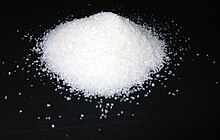
A superabsorbent polymer (SAP) (also called slush powder) is a water-absorbing hydrophilic homopolymers or copolymers[1] that can absorb and retain extremely large amounts of a liquid relative to its own mass.[2]
Water-absorbing polymers, which are classified as hydrogels when mixed,[3] absorb aqueous solutions through hydrogen bonding with water molecules. A SAP's ability to absorb water depends on the ionic concentration of the aqueous solution. In deionized and distilled water, a SAP may absorb 300 times its weight[4] (from 30 to 60 times its own volume) and can become up to 99.9% liquid, and when put into a 0.9% saline solution the absorbency drops to approximately 50 times its weight.[citation needed] The presence of valence cations in the solution impedes the polymer's ability to bond with the water molecule.
The SAP's total absorbency and swelling capacity are controlled by the type and degree of cross-linkers used to make the gel. Low-density cross-linked SAPs generally have a higher absorbent capacity and swell to a larger degree. These types of SAPs also have a softer and stickier gel formation. High cross-link density polymers exhibit lower absorbent capacity and swell, and the gel strength is firmer and can maintain particle shape even under modest pressure.
Superabsorbent polymer: Polymer that can absorb and retain extremely large amounts of a liquid relative to its own mass.[5] Notes:
- The liquid absorbed can be water or an organic liquid.
- The swelling ratio of a superabsorbent polymer can reach the order of 1000:1.
- Superabsorbent polymers for water are frequently polyelectrolytes.
Superabsorbent polymers are crosslinked in order to avoid dissolution. There are three main classes of SAPs:
1. Cross‐linked polyacrylates and polyacrylamides
2. Cellulose‐ or starch‐acrylonitrile graft copolymers
3. Cross‐linked maleic anhydride copolymers[1]
The largest use of SAPs is found in personal disposable hygiene products, such as baby diapers, adult diapers and sanitary napkins.[6] SAPs were discontinued from use in tampons due to 1980s concern over a link with toxic shock syndrome.[citation needed] SAPs are also used for blocking water penetration in underground power or communications cable, in self-healing concrete,[7][8] horticultural water retention agents, control of spill and waste aqueous fluid, and artificial snow for motion picture and stage production. The first commercial use was in 1978 for use in feminine napkins in Japan and disposable bed liners for nursing home patients in the United States. Early applications in the US market were with small regional diaper manufacturers as well as Kimberly Clark.[9]
- ^ a b Hawaii Energy and Environmental Technologies (HEET) Initiative. July 2016.
- ^ Horie, K, et al., 890.
- ^ Kabiri, K. (2003). "Synthesis of fast-swelling superabsorbent hydrogels: effect of crosslinker type and concentration on porosity and absorption rate". European Polymer Journal. 39 (7): 1341–1348. Bibcode:2003EurPJ..39.1341K. doi:10.1016/S0014-3057(02)00391-9.
- ^ Mignon, Arn; Vermeulen, Jolien; Snoeck, Didier; Dubruel, Peter; Van Vlierberghe, Sandra; De Belie, Nele (2017-10-28). "Mechanical and self-healing properties of cementitious materials with pH-responsive semi-synthetic superabsorbent polymers". Materials and Structures. 50 (6): 238. doi:10.1617/s11527-017-1109-4. ISSN 1871-6873. S2CID 255318116.
- ^ Horie, K.; Barón, Máximo; Fox, R. B.; He, J.; Hess, M.; Kahovec, J.; Kitayama, T.; Kubisa, P.; Maréchal, E.; Mormann, W.; Stepto, R. F. T.; Tabak, D.; Vohlídal, J.; Wilks, E. S.; Work, W. J. (1 January 2004). "Definitions of terms relating to reactions of polymers and to functional polymeric materials (IUPAC Recommendations 2003)". Pure and Applied Chemistry. 76 (4): 889–906. doi:10.1351/pac200476040889. S2CID 98351038.
- ^ Sun, Fang; Messner, Bernfried A. (December 5, 2006), Manufacture of web superabsorbent polymer and fiber, archived from the original on August 29, 2011
- ^ Snoeck, Didier; Van Tittelboom, Kim; Steuperaert, Stijn; Dubruel, Peter; De Belie, Nele (2012-03-15). "Self-healing cementitious materials by the combination of microfibres and superabsorbent polymers". Journal of Intelligent Material Systems and Structures. 25: 13–24. doi:10.1177/1045389X12438623. hdl:1854/LU-6869809. S2CID 92983639.
- ^ Mignon, Arn; Devisscher, Dries; Graulus, Geert-Jan; Stubbe, Birgit; Martins, José; Dubruel, Peter; De Belie, Nele; Van Vlierberghe, Sandra (2017-01-02). "Combinatory approach of methacrylated alginate and acid monomers for concrete applications". Carbohydrate Polymers. 155: 448–455. doi:10.1016/j.carbpol.2016.08.102. hdl:1942/22766. ISSN 0144-8617. PMID 27702534. S2CID 46760339.
- ^ Mulder, Douglas C.; O'Ryan, David E. (December 31, 1985), Method and apparatus for powder coating a moving web: US 4561380 A